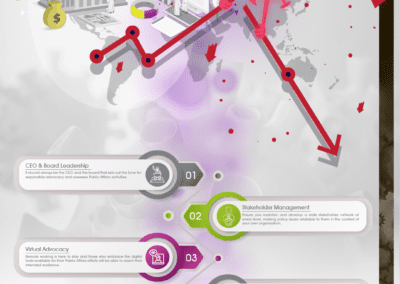COVID-19 has significantly changed the relationship between business and government as the crisis impacted every country, threatening not only its people but also its economies. Governments consolidated their powers to enable rapid decision-making on lockdowns, introducing special emergency measures, public health guidelines, recovery funding, and post-lockdown plans for reopening societies.
Governments have had to rely on businesses to step forward quickly to provide key workers, essential supplies, services, and advice. COVID-19 is a significant new responsibility for the corporate sector which now needs to team up with the government to restart the economy. Collaboration between the public and private sectors will help drive recovery. Neither business nor government can do this alone. At a time when governments depend on the continued cooperation of the corporate sector to help manage the ongoing demands of COVID-19, Public Affairs needs to react immediately to the new situations around it and is, therefore, one of the fastest-moving communications specialists during this crisis.
‘COVID-19 has seen a high level of lobbying and public affairs activity as businesses seek to influence the policies employed by governments to manage the economic fallout of the pandemic.’ explains Abdulrahman Inayat, Director, and Co-Founder of W7Worldwide. ‘Building the right relationships now will ensure you create a positive climate of opinion about your company as being part of the solution going forward. There are many strategies companies can deploy to ensure they are included in the new close dialogue between government and industry.’
W7Worldwide has produced a helpful 7-step guide for companies to build their COVID-19 Recovery Public Affairs Programme. (Click Here to Read Full Report).
- CEO & Board Leadership – It should always be the CEO and the board that sets out the tone for responsible advocacy and oversees activities. They inform stakeholders about policies, statistics, and other information regarding sensitive issues associated with the business.
- Stakeholder Management – Public affairs is the bridge connecting companies with relevant stakeholders, such as government departments, civil servants, business groups, and professional/trade organizations.
- Virtual Advocacy – Public Affairs practitioners need to take advantage of the fact that in-person meetings, consultations, and events will be taking place virtually for the foreseeable future. The benefit of this is that there is greater accessibility, with governments in full listening mode.
- Increased Government Involvement – Every business sector will see increased involvement from the state with various interventionist measures to steer the recovery of their country. The repercussions of this can include taxes, an expectation of better support for employees, and businesses being asked to play a role in the delivery of social and economic agenda.
- Transparency – To reduce the risk of undeclared conflict of interest, companies that are engaging with the government in stimulus packages should disclose to external stakeholders who are ultimately benefiting. Society will not only remember what companies did to save lives and the economy but how they did it.
- Agile Planning – Governments will be working on urgent recovery efforts for the coming months to bring their economies back on course. Public Affairs needs to closely monitor for developments in all areas that may affect an organization as this remains a fast-moving situation.
- Future Opportunity – As governments are seeking to kick-start the economy and encourage businesses to recover, there is the opportunity to help shape a favourable regulatory landscape. Provide expert insight, backed up with facts and figures, adopting an approach of advising the government on how your industry sector can survive the challenges caused by the COVID-19 crisis.
W7Worldwide carried out a recent poll to understand Public Affairs Practitioners’ current focus, with most of the English (24.5%) and Arabic (19.7%) respondents seeing ‘Agile Future Planning’ as their top priority. ‘Supporting Remote Working’ practices are considered important by both the Arabic and English sample (24.9% Arabic/15/1% English. In comparison to Arab respondents (9.4%) a greater number of English survey participants (18.9%) prioritized ‘An Increase in Public Affairs Activity.’
The greatest change emerging from the pandemic is the social change across the globe in every country. Public Affairs strategies need to align with the changing way we communicate not only with policy and decision-makers but with society at large. Governments wish to protect the reputation of their country in the way they are seen to contain, manage and emerge from the COVID-19 crisis, which will ultimately shape public opinion and their place on the global stage. This is a time when business and industry can make an important and meaningful contribution to national recovery efforts and show that we really are all in this together.
Public Affairs can be a complex communications discipline because companies need to understand how to galvanise the right support and conduct themselves in an ethical and transparent manner. W7Worldwide provides its 7-step guide to help businesses and CEOs formulate their ‘Public Affairs Towards COVID-19 Recovery’ strategies and plans.
‘The pandemic has forever transformed the way we live, socialize, work, and do business. As the world is changing its behavior and innovates, so too must the brand.’ says Abdulrahman Inayat, Co-Founder of W7Worldwide. ‘Companies need to plan for the post-COVID-19 future, updating their PR and Communications strategies accordingly to connect with customers and the public in new ways. This is the perfect opportunity for businesses to take note of the changing digital landscape to create innovative Digital PR campaigns that drive brand awareness and ultimately win new customers.’
W7Worldwide recommends that companies take 7 essential steps to build their COVID-19 Post Lockdown Digital PR strategy:
- Develop Short-term Strategies – Focus on short-term goals linked to immediate business priorities. Take small steps and focus on engagement rather than links for the moment.
- Review Social Media Posting Schedules – Try posting at different times during the day and evaluate results with social media analytics. Post in real-time and look for content gaps others aren’t filling.
- Adjust the Tone of Voice – Adjust the tone of voice to public sentiment and the economic climate. Empathy is critical at a time when people still feel uncertain and concerned about the future.
- Act Local – Every country and region will open at different rates; what people can do will not be the same everywhere. For communicators, this means thinking and acting hyper-local when it comes to digital PR and marketing.
- Rebut Fake News and Misinformation – Media monitoring should be essential to any digital PR and COVID-19 crisis management program. Monitor online mentions of the brand or organization associated with COVID-19 and immediately expose misinformation.
- Focus on Thought Leadership – One of the most effective ways to stay in the public eye is through thought leadership. Right now, journalists and the public want to know how businesses are dealing with the challenges of COVID-19 and how they are managing their way out of lockdown.
- Prepare a Recovery Strategy – Digital PR is integral to maintaining brand reputation and SEO health. Without links, coverage, and mentions, any Digital PR program will lose momentum. The long-term strategy needs to be readiness, so use this time to do research and plan ahead.
Planning into an uncertain future is challenging, but it offers many opportunities for those who are smart about maximizing the growth of digital PR to future-proof their business and brand. A key factor in resilience is to understand how much COVID-19 will reshape consumer behaviors in the future. In the coming months, there will be a lot less face-to-face interaction when doing business and companies need to maximize their digital PR efforts to introduce their brand and foster loyal relationships.



